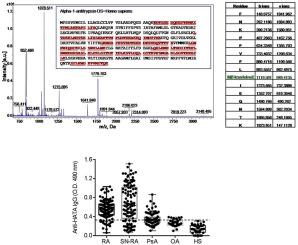Journal of Autoimmunity ( IF 12.8 ) Pub Date : 2020-05-28 , DOI: 10.1016/j.jaut.2020.102470 Tania Colasanti 1 , Danilo Sabatinelli 1 , Carmine Mancone 2 , Alessandra Giorgi 3 , Arbi Pecani 4 , Francesca Romana Spinelli 1 , Alessandra Di Giamberardino 2 , Luca Navarini 5 , Mariangela Speziali 1 , Marta Vomero 1 , Cristiana Barbati 1 , Carlo Perricone 1 , Fulvia Ceccarelli 1 , Annacarla Finucci 1 , Alessandra Ida Celia 1 , Damiano Currado 5 , Antonella Afeltra 5 , Maria Eugenia Schininà 3 , Vincenzo Barnaba 6 , Fabrizio Conti 1 , Guido Valesini 1 , Cristiano Alessandri 1

|
Rheumatoid arthritis (RA) is a chronic autoimmune disease and rheumatoid factor (RF) and anti-citrullinated protein antibodies (ACPA) are the most frequently detected autoantibodies (autoAbs). To date, more than 20% of RA cases are still defined as seronegative forms (seronegative RA, SN-RA). The aim of this study was to identify new antigenic targets of autoAbs in RA patients, which can also be recognized in SN-RA. Using a proteomic approach, we tested sera from SN-RA patients by analyzing synovial fluid (SF) proteins from these patients. Sera from SN-RA patients revealed a strong reactive spot, corresponding to alpha 1 antitrypsin (A1AT). Reverse-phase nanoliquid chromatography and tandem mass spectrometry (Matrix Assisted Laser Desorption/Ionization-Time Of Flight, MALDI-TOF/TOF) confirmed the presence of A1AT in SF and showed that homocysteinylation was one of the post-translational modifications of A1AT. Homocysteinylated (Hcy)-A1AT immunoprecipitated from SN-RA patients' SFs and in vitro modified Hcy-A1AT were used as antigens by Enzyme-Linked ImmunoSorbent Assay (ELISA) to test the presence of specific autoAbs in sera from 111 SN-RA patients, 132 seropositive (SP)-RA patients, and from 95 patients with psoriatic arthritis, 40 patients with osteoarthritis, and 41 healthy subjects as control populations. We observed that a large portion of SN-RA patients (75.7%), and also most of SP-RA patients' sera (87.1%) displayed anti-Hcy-A1AT autoAbs (anti-HATA). Native A1AT was targeted at a lower rate by SP-RA patients autoAbs, while virtually no SN-RA patients' sera showed the presence of anti-native A1AT autoAbs. In conclusion, anti-HATA can be considered potential biomarkers for RA, also in the SN forms. The discovery of novel autoAbs targeting specific autoantigens can represent higher clinic significance for all RA patients’ population.
中文翻译:

同型半胱氨酸化 α1 抗胰蛋白酶作为血清阴性类风湿关节炎患者自身抗体的抗原靶点。
类风湿关节炎 (RA) 是一种慢性自身免疫性疾病,类风湿因子 (RF) 和抗瓜氨酸蛋白抗体 (ACPA) 是最常检测到的自身抗体 (autoAbs)。迄今为止,超过 20% 的 RA 病例仍被定义为血清阴性形式(血清阴性 RA,SN-RA)。本研究的目的是确定 RA 患者中自身抗体的新抗原靶点,这些靶点也可以在 SN-RA 中识别。使用蛋白质组学方法,我们通过分析来自这些患者的滑液 (SF) 蛋白来测试来自 SN-RA 患者的血清。来自 SN-RA 患者的血清显示出强烈的反应点,对应于 α 1 抗胰蛋白酶 (A1AT)。反相纳米液相色谱和串联质谱(基质辅助激光解吸/电离-飞行时间,MALDI-TOF/TOF) 证实了 A1AT 在 SF 中的存在,并表明同型半胱氨酸化是 A1AT 的翻译后修饰之一。从 SN-RA 患者的 SF 中免疫沉淀的同型半胱氨酸化 (Hcy)-A1AT 和体外修饰的 Hcy-A1AT 被酶联免疫吸附试验 (ELISA) 用作抗原,以检测 111 名 SN-RA 患者、132 名血清阳性 (SP)-RA 患者和 95 名银屑病关节炎患者血清中特异性自身抗体的存在, 40 名骨关节炎患者和 41 名健康受试者作为对照人群。我们观察到大部分 SN-RA 患者 (75.7%) 和大多数 SP-RA 患者的血清 (87.1%) 显示抗 Hcy-A1AT 自身抗体(抗 HATA)。SP-RA 患者 autoAbs 以较低的比率靶向天然 A1AT,而几乎没有 SN-RA 患者的血清显示存在抗天然 A1AT autoAbs。总之,抗 HATA 可以被认为是 RA 的潜在生物标志物,也是 SN 形式。



























 京公网安备 11010802027423号
京公网安备 11010802027423号